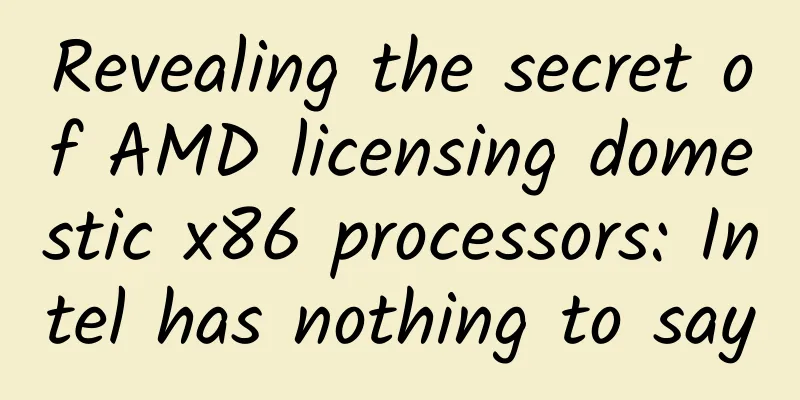Revealing the secret of AMD licensing domestic x86 processors: Intel has nothing to say

|
The first quarter of 2016 has passed, and AMD has released a horrific loss report. However, the difference is that the atmosphere on Wall Street has changed this time. Even though the financial report still shows a huge loss, it did not cause AMD's stock price to plummet like last year. Compared with the 20% plunge at this time last year, AMD's stock price soared by more than 50% today. Is this because Wall Street has seen hope for profit? Or is AMD's bet in 2016 about to be realized? All of them, but in my opinion, the main reason is that AMD has reached a joint venture licensing deal with the Chinese Academy of Sciences. This is actually AMD showing Wall Street a new business model for the future, a model that is similar to ARM but far exceeds ARM's model of relying on intellectual property to make profits. It can be said that AMD's experience in the semi-custom market has helped it find a new way to survive. Now, AMD has only licensed its semi-custom technology to China. From now on, the company is no longer fighting alone. The CPU architecture it designed will have a Chinese derivative version and will expand its territory in the Chinese market. The profit may be much lower than that of independent sales, but at least the survival alarm should have come to an end for the time being. So, the question arises again - did Intel agree to AMD's unauthorized licensing of the X86 architecture to a Chinese company? Did the US government allow it? In response, an AMD spokesperson said: The transaction does not violate the cross-licensing agreement with Intel, and is fully compliant with the export regulations set by the US government. Is it really as simple as AMD says? As an editor who has done in-depth research on the AMD/Intel cross-licensing agreement, I would like to make a rough analysis and speculation on some confusion in media reports and some obstacles that the transaction may still face in the future. Intel may have nothing to say After AMD announced the news, many media immediately questioned whether the transaction undermined the cross-licensing agreement between AMD and Intel. It is generally believed that AMD's unilateral licensing of X86 technology to third-party companies is expressly prohibited in the cross-licensing agreement, so Intel will inevitably oppose it. However, according to my understanding, although AMD does not have the right to license the X86 instruction set (ISA) related technologies to third parties, the independently designed X86 CPU architecture (such as the Bulldozer architecture and the future Zen architecture, etc.) can be licensed. To put it more simply, the former is the basic patent technology used to create the X86 CPU, which is currently only held by Intel, AMD and VIA in the world, while the latter is a designed public version CPU architecture, which is an intellectual property that AMD holds independently and can use. After all, Intel does not own AMD, so it cannot interfere with AMD's normal business practices. Some people may say that Intel is the creator and owner of the X86 instruction set, and therefore has the right to deny AMD's transfer of X86 intellectual property rights, just like it opposed AMD's spin-off of the GlobalFoundry factory. Unfortunately, today's X86 patent technology has become very complex. Intel does not own all patents related to the X86 instruction set. Especially after AMD took the lead in launching the 64-bit AMD X86-64 extended instruction set, Microsoft pressured Intel to comply. AMD has largely mastered the right to speak on an equal footing with Intel, so there was the subsequent "cross-licensing". What is "cross-licensing"? It means that you can use my patent technology and I can use your patent technology. The number of each other's patents may not be equal, but the importance is basically balanced. Without one, neither can "survive". Therefore, if AMD does not license the technology protected in the "cross-agreement" to a third party, it will be difficult for Intel to take action even if it does not like it (after all, it will indirectly add a competitor). Unless... Intel wants to play some "shady" tricks and put pressure on AMD through the US government to prohibit the exposure of important technologies such as X86 to competing countries. The US government may still make a statement Before discussing the attitude of the US government, we still need to understand clearly what technology AMD has licensed to China. As mentioned above, it is unlikely that AMD will license patents related to the X86 instruction set. After all, it does not hold all patents, and it will also destroy the "cross-agreement" with Intel. So, what are the patent technologies that belong only to AMD but meet the official explanation of "microprocessor technologies and system-on-chip technologies" (CEO's original words at the earnings conference)? There are two key words here: microprocessor and SoC (system-on-chip). When it comes to AMD's APU products, everyone knows what they are - a processor product that integrates the CPU and GPU into the same chip. When it comes to SoC, everyone is familiar with it, but they always think it is different from APU. Of course, if they are divided from the internal composition and functions of the chip, the two are indeed different, but if they are divided from the perspective of design and production, both belong to the same family - the current SoC chip may integrate more chips with other functions, such as 3G/4G baseband chips, DSPs, or north and south bridge control chips. It's not that APU cannot integrate these, but the initial positioning did not take such needs into consideration. Today's APU also integrates north and south bridge chips, and semi-custom products for the embedded market have integrated DSPs and even basebands. Therefore, I boldly guess that what AMD licensed to China is the already designed CPU core, such as the Jaguar microkernel used in PS4 and Xbox One and the upcoming Zen core; as well as the related technology of integrating the core with other chip cores with different functions into the same SoC, such as the interconnect fabric of the CPU core and GPU core. In particular, everyone should not forget that AMD is one of the founders of the Heterogeneous System Architecture (HSA) Foundation and a senior supporter of the HSA development path, and HSA is almost a recognized future trend in the server and supercomputing industries. So why does AMD dare to say that the transaction is in full compliance with US export regulations, and why is it so sure that the US government will not interfere? Because, similarly, Nvidia has done the same thing of opening up chip architecture licensing (opening up Kepler GPU architecture licensing), Intel has done it (taking a stake and licensing Atom architecture to RDA), IBM has done it (opening up PowerPC instruction set to several Chinese startups), MIPS has also done it (I won’t say much about Loongson)… There are many players in the high-performance server market, so what can AMD, which now has less than 1% of the server market share, do? However, after all, it is X86, and after all, it is the most important instruction set architecture leading the global supercomputer market. If AMD's Zen unexpectedly succeeds unprecedentedly and makes China's server SoC based on Zen design receive unprecedented praise, the US government will still speak. Of course, that will be at least two years later. At this stage, everyone has not even seen a product blueprint, and it should not be a big problem for AMD to smoothly receive several hundred million US dollars in licensing fees. Cross-licensing disputes Back to the controversial issue of cross-licensing, what I can't understand the most is why the media has been questioning whether AMD may have violated the agreement and may have caused dissatisfaction with Intel. The agreement between the two parties was signed in 2009, and since then Intel has reached X86 licensing deals with China's Spreadtrum Communications and RDA (also related to SoC design and manufacturing). AMD's deal today is literally no different from Intel's original deal. If it must be believed that the agreement has been violated, it is most likely that AMD believes that Intel violated it first, so it does not have to follow it now. In fact, the cross-licensing agreement between AMD and Intel is not very long, complicated or difficult to understand. The link is here. Interested netizens can study it on their own. It does not specifically mention which patent technologies are restricted from transfer, but it is safe to assume that a designed CPU core should not be among them. After all, Intel also does this. In addition, the agreement and AMD's explanation at the earnings conference also mentioned the issue of corporate structure. The editor believes that AMD should hold at least 51% of the shares of the joint venture, that is, the company should continue to be controlled by AMD in structure. In this way, AMD's technology transfer can also be considered to have no change in the actual controller, which is in line with the provisions of the agreement to a certain extent. I hope that the Chinese Academy of Sciences can benefit from it. Having written this far, some netizens may have seen what the editor wants to hint at: First of all, AMD licensed the kernel, not the X86 instruction set. This means that the Chinese Academy of Sciences cannot change AMD's CPU design, so there will be no so-called domestic "X86 Chinese chip". Although it cannot be modified, the design can still be seen. Whether the Chinese Academy of Sciences can learn from AMD by "looking" will be a topic worth thinking about. Secondly, AMD did not disclose how many patent technologies it has licensed and which patent technologies it has licensed. The importance and value of these technologies can only be evaluated after the product is released. AMD said that the patent licensing part alone is worth $293 million, and thereafter, it can also receive a royalty for each chip produced. It is still difficult to say whether the restrictions are too expensive, but we hope that China will not waste money because of its eagerness to obtain high-end CPU technology. Furthermore, AMD emphasized that the deal has been completed, meaning that the purchase fee from China has been received in installments, and the full $293 million will be received in the next one or two years. The first product of the joint venture is also expected to take another year or two, and it is hard to say whether the US government will block it again due to the sensitivity of the technology, especially considering the increasingly tense relationship between China and the United States. Finally, Intel's silence does not mean that it is happy with AMD's behavior. AMD has been going against the tide in recent years and has come up with many new technologies that are enough to subvert the industry. The market rumors that Microsoft, Apple, Qualcomm, Samsung, Google and even Intel want to acquire AMD are not groundless. If one day it really happens, and Intel acquires (even partially) AMD, whether the joint venture can continue to obtain authorization in the future will immediately become a question. In the past, considering the monopoly issue, the US government may not necessarily let it go. Now considering the issue of competition from China, the US government's attitude may be different. Again, I hope that the Chinese Academy of Sciences can benefit from the transaction. As a winner of Toutiao's Qingyun Plan and Baijiahao's Bai+ Plan, the 2019 Baidu Digital Author of the Year, the Baijiahao's Most Popular Author in the Technology Field, the 2019 Sogou Technology and Culture Author, and the 2021 Baijiahao Quarterly Influential Creator, he has won many awards, including the 2013 Sohu Best Industry Media Person, the 2015 China New Media Entrepreneurship Competition Beijing Third Place, the 2015 Guangmang Experience Award, the 2015 China New Media Entrepreneurship Competition Finals Third Place, and the 2018 Baidu Dynamic Annual Powerful Celebrity. |
>>: Huawei P9 review: Is it true that it is half a year ahead of iPhone 7?
Recommend
CTR: Panoramic insights into the digitalization of car life in 2022
Research background and definition of car life di...
Touch Technology helps the completion of the "Xiamen Game Innovation Center Project"
On May 15, 2015, the Jimei District Government of...
Why can wind turbines generate so much electricity when their rotation speed is so slow?
On the vast sea, rows of wind turbines stand, slo...
Fantastic ideas: 10 extremely practical smart office devices
[51CTO Translation] The products to be introduced...
A female national security police officer captured a spy who had been lurking for 10 years! Details revealed for the first time
Hear in silence, see in formlessness The turbulen...
15 days to boost store traffic, applicable to all restaurants, a must-learn to break through the bottleneck of order volume
15 days to boost store traffic, applicable to all...
Heavy snow丨Cold clouds cover the sky, white snow falls on the ground
"At first the sound of tiles was heard spars...
It can make you sweet, but it can also make you acutely poisoned...
Did you know that the elements can be deceiving? ...
She did not have a PhD, but she was once the person that structural biologists most wanted to "collaborate" with.
In order to simplify and visualize the complex th...
Are you young but have wrinkles all over your neck? These behaviors will make your neck wrinkles deeper and deeper...
This article was reviewed by: Xiaobo Zhou, Doctor...
Ziyang Mini Program Investment Company, how much does the paper product mini program cost?
What is the investment cost of Ziyang Paper Produ...
React Native-Currently the hottest front-end technology
[[160497]] As a product manager, have you ever en...
Why can’t we retain new users? Here are 4 best solutions
Why is it that even though we have been attractin...
Cross-border e-commerce: Amazon newbies can open stores around the world with zero basic knowledge
Course Catalog: ├──01. Lesson 1: Understanding Am...
Where did you buy your phone? Physical store or e-commerce platform, the two are very different
introduction Looking at the emerging fields in th...









